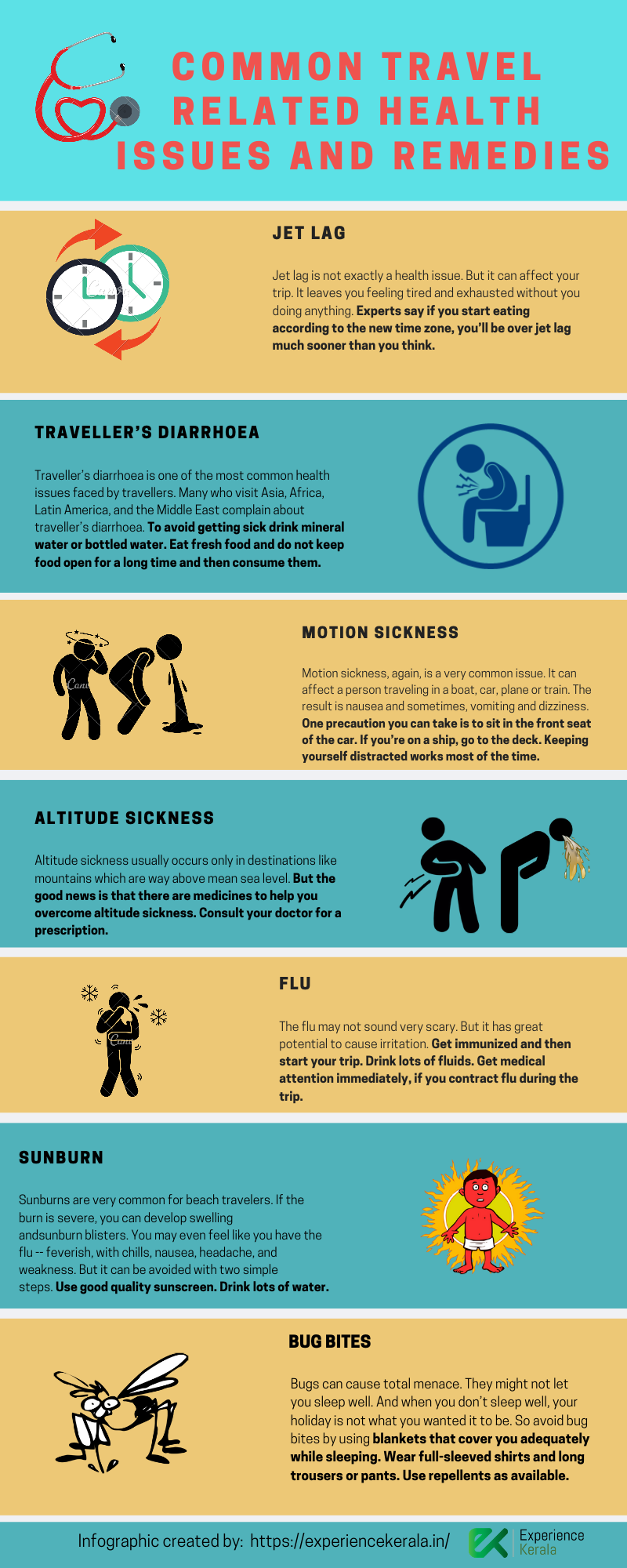Why Altitude Sickness Sucks More than Anything while Travelling? How to Avoid it?
Many holiday destinations have high mountain ranges and hill stations. If you are visiting any such destination where you have to go thousands of metres above sea level, you might need to be careful of altitude sickness. As you read further, you will find out what altitude sickness is, what are its symptoms and how you can treat it.
What is Altitude Sickness?
When you go higher up the earth’s atmosphere, your body is affected because of various reasons. Some of these reasons are decreased air pressure, low humidity levels, increased UV radiation and of course, cold. Such drastic changes in the environment around you cause “Altitude Sickness. It usually begins when you reach a height of 2500 metres or 8000 ft. But some travellers can feel altitude sickness even at lower altitudes, depending on their health and body type.
The major reason for altitude sickness is an overall decrease in the amount of oxygen relative to the air pressure. So even though oxygen content in the atmosphere remains 21% at least up to a height of 20,000 metres, you will still experience altitude sickness because of decreased air pressure. That is because when air pressure decreases, your body requires more oxygen. But you don’t get more oxygen.
The symptoms of Altitude sickness can increase in severity as you go to higher altitudes. Dehydration may also occur since your lungs will start losing water.
• Contributing factors towards the onset and severity of the altitude sickness are the rate of ascent, the altitude ascended and the exertion which has occurred at the high altitude.
• The most common cause behind altitude sickness is rapid ascent which results in all the symptoms of altitude sickness.
Altitude Sickness is of three types
1. Acute Mountain Sickness (AMS)
It is the most common type of altitude sickness. It affects almost half the travellers who live in low altitude regions but then come and sleep at higher altitudes. Some feel sick at 3000 metres, some at 2400 metres, while some even get sick at 2000 metres. The symptoms of AMS can occur anytime within the first 24 hours of arriving at high altitude.
Symptoms:
AMS can be diagnosed looking at the following symptoms:
- Headache
- Lack of appetite
- Tiredness
- Disturbed sleep
- Lightheadedness
- Nausea or vomiting
Symptoms could be mild or severe. If you encounter these symptoms, do not go higher up until the symptoms they subside. Otherwise, there could be major complications. Most likely, the symptoms will subside within a day.
Every person has a different level of susceptibility towards altitude sickness. Symptoms can aggravate after overexertion. Other than these primary symptoms which are often accompanied by disorders such as peripheral oedema, nose bleeding, breathlessness, rapid pulse, there are several other symptoms too. In some cases, where the person is highly susceptible to altitude sickness, life-threatening situations may also develop. We will talk about them when we discuss the other two types of altitude sickness.
Precautions:
There are many precautions you can take to successfully avoid AMS.
- The best way to avoid AMS is to ascend slowly. Do not increase your sleeping altitude by more than 500 metres per day. Take a day’s rest for every 1000 metres that you ascend.
- Even if you do climb to very high altitudes, try to come back to a lower altitude before it is sleep time. This will help you to adjust easily.
- If you have the habit of regularly drinking tea, coffee, soda or any other drinks containing caffeine, do not stop drinking them. Stopping them will aggravate AMS.
- You can take preventive medicines to avoid AMS. One such medicine is Acetazolamide. Take this medicine one day before ascent and continue it for 48 hours or till you reach the highest point of your trip, whichever comes first. It can cause a few side effects like frequent urination, numbness of hands and feet, drowsiness, blurry vision and nausea. Pregnant women must avoid Acetazolamide.
- If you are allergic to Acetazolamide, then take Dexamethasone. Please note that Acetazolamide is a sulfa medicine and some may be allergic to such medicine.
- You can take aspirin to prevent headaches, which is the most common symptom of AMS.
Treatment:
In order to treat AMS, you may have to take rest, descend and take medicine. One thing you must definitely avoid is ascending to higher altitudes.
- Take non-prescription medicines for headache, nausea and vomiting. Aspirin will prove to be helpful for headache and Zofran for nausea and vomiting.
- If the symptoms of AMS do not subside in one or two days, start descending to lower altitudes. You will feel much better.
- If the symptoms are severe, you might have to take supplemental oxygen via a tank or a concentrator. Many prominent high-altitude regions will have oxygen companies. Take a prescription from your doctor in advance so that you can take oxygen from one of these companies.
- Acetazolamide and Dexamethasone are useful not only to prevent AMS but also to treat it
2. High Altitude Pulmonary Edema (HAPE)
High Altitude Pulmonary Edema is a dangerous type of altitude sickness. The results could be fatal. Fluid begins to accumulate in the lungs because of leakage in the lung capillaries. HAPE is not a common type of altitude sickness, but it can occur when you rapidly ascend to altitudes higher than 2500 metres.
Symptoms:
HAPE can be diagnosed by looking at the following symptoms
- Shortness of breath
- Difficulty walking uphill
- Cough with pink, frothy sputum
The symptoms of HAPE may not begin to appear immediately like with AMS. Instead, you might see the symptoms only after 2 or 4 days. They can get worse gradually and you might start feeling breathless even while resting. Please note that you may not have symptoms of AMS if you have HAPE.
Precautions:
- As with AMS, the best preventive measure you can take to avoid HAPE is to ascend slowly. You must do this, especially if you have had HAPE in the past.
- For HAPE, preventive medicines may include tadalafil, nifedipine, acetazolamide or dexamethasone. But doctors will not recommend them unless you have had a history of HAPE.
Treatment:
If you notice symptoms of HAPE, you need to act immediately. The first thing you need to do is descend as soon as possible without a second thought. Then, seek medical attention. If you do not descend immediately, the situation will get worse. You might even reach a position where you unable to walk. And sometimes, the complications can be life-threatening.
In order to treat, you can try the following methods:
- Take rest and stay warm.
- Medicines like Nifedipine can help treat HAPE.
- The most effective way to treat HAPE is to take supplemental oxygen. If, due to some circumstances, you are not able to descend, take supplemental oxygen as soon as possible. It can save your life.
- A temporary treatment is using a portable hyperbaric chamber where you can take oxygen.
- The hyperbaric chamber can be very useful. It is an inflatable pressure bag. You can enter the bag and it can be inflated with a foot pump. Once inflated, the air you breathe will be similar to the air you breathe in low altitude regions. As a result, the oxygen content in your blood increases, giving you immediate relief. One good thing is that you can remain in this chamber for several hours without any problem.
- Â But this is only temporary. Descend as soon as the opportunity arises.
3. High-Altitude Cerebral Edema (HACE)
High-Altitude Cerebral Edema is a rare type of altitude sickness. It is a life-threatening medical condition. Fluids start accumulating in the brain because of leakage in the brain capillaries. This causes the brain to swell. And yes, it is as bad as it sounds.
Symptoms:
Since HACE is a sickness related to the brain, most of its symptoms are also brain-related. The following are the symptoms of HACE:
- Difficulty walking straight
- Drowsiness
- Confusion and irritability
- Feeling of intoxication
- Severe tiredness or weakness.
Precautions:
The preventive measures of HACE are the same as the preventive measures of AMS. So scroll back up to see the precautions for HACE.
Treatment:
Just like HAPE, HACE is also a life-threatening medical condition. So act immediately if you notice symptoms and descend as soon as possible. Apart from the descent, you can try the following treatments:
- Most of the treatments are similar to the treatment procedures of HAPE. For example, even for HACE, you need to take supplemental oxygen or use the portable hyperbaric chamber.
- An important medicine that helps treat HACE is dexamethasone. Take this medicine with you if you know you’re going to be anywhere above 3000 metres from mean sea level. As soon as you notice symptoms of HACE, take one dose of dexamethasone. The recommended dosage is 8 to 10 mg. Then, for every six hours, take a dosage of 4 mg until you descend.
What can we say in conclusion? Beware of altitude sickness when visiting high-altitude sickness. Keep checking if you’re developing any of the symptoms mentioned in this blog. You can do much to prevent altitude. The foremost thing is to ascend slowly. And when you observe the symptoms, stop ascending. If symptoms get severe, start descending.
Some important points to keep in mind:
- Caution must be taken while skiing, hiking and other activities during the first 24 hours, as overexertion during these activities may prove to be fatal.
- Alcohol, sleeping pill and all kinds of respiratory depressants should be avoided. Alcohol aggravates acute mountain sickness by causing dehydration. So if you get altitude sickness, you must avoid alcohol for the first 24 hours.
- Drink lots of water
Hope the above information will help you be able to deal with altitude sickness. If you keep in mind the preventive measures, you will be able to avoid it altogether. Here’s wishing you a safe and memorable travel experience no matter where you go!

Check another one of our blog which discusses how you can deal with other sicknesses you might encounter during your holiday.
Other Travel Related Sickness?








